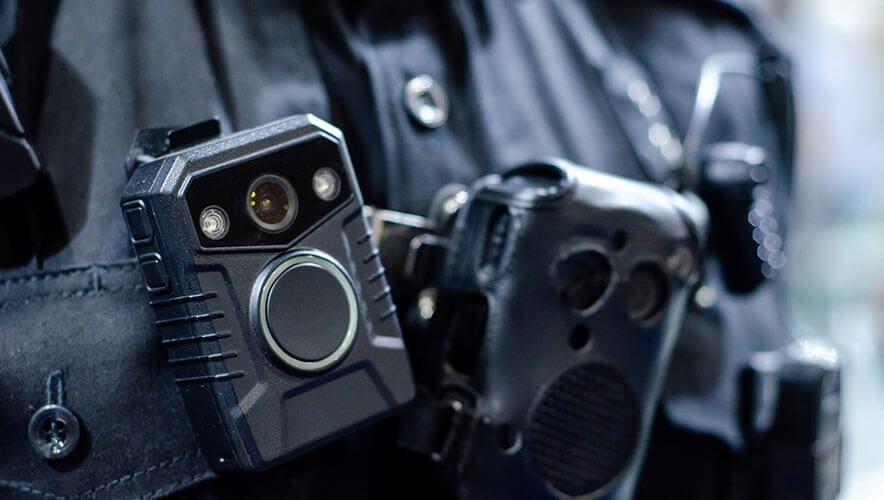ICE to Require Agents in Five U.S. Cities to Use Body-Worn Cameras
U.S. Immigration and Customs Enforcement (ICE) is rolling out a new program that requires its agents in five U.S. cities to use body-worn cameras when they interact with the public.
“Public trust is dependent on transparency, and our ability to effectively conduct our mission is dependent on public trust,” said Deputy Director and Senior Official Performing the Duties of the Director Patrick J. Lechleitner in a press release. “The deployment of body-worn cameras to our officers and agents assists in building that public trust through transparency and accountability. It is an essential element in our public safety and national security mission.”
ICE, part of the U.S. Department of Homeland Security (DHS), will deploy 1,600 body-worn cameras to two of its components—Homeland Security Investigations and Enforcement, and Removal Operations—in five cities: Baltimore, Buffalo, Detroit, Philadelphia, and Washington, D.C. ICE anticipates that it will fully implement the body-worn camera program across the components by 30 September 2025, subject to congressional funding, according to a privacy impact report from the agency.
Publicly available information did not list the type of cameras that ICE will use, and the agency was not able to provide manufacturer information prior to Security Management’s press time.
The program requires agents and support staff be trained at least annually on several aspects, including:
- Body-worn camera operation, maintenance, and care
- Appropriate handling of body-worn camera recordings
- Proper labeling and categorization of body-worn camera footage
- Privacy compliance and procedures for redacting and sharing body-worn camera data
- Required wear and activation, optional wear and activation, deactivation, and non-permissible uses of body-worn cameras
- Officer/agent and public safety considerations when wearing or using a body-worn camera
- Laws, regulations, and policies governing the use of body-worn cameras
- Civil rights and civil liberties considerations
The cameras have a battery life of roughly 12 hours and have a programmed buffer designed to record activities for 30 seconds prior to an officer activating the camera.
“The buffer is constantly overwritten until the camera is activated,” the privacy impact report explained. “Upon activation, the pre-event buffer video recording becomes the start of the recording at activation. The system does not record when the body-worn camera is turned off.”
Video footage from the cameras will then be uploaded to ICE’s Digital Evidence Management System—a cloud-based, FedRAMP certified system. Only designated ICE personnel will have access to the recorded video data. Non-evidentiary data will be retained for 60 days; potentially evidentiary data will be retained for three years; and evidentiary data will be retained for three years or in accordance with retention requirements for the case file the data is assigned to.
ICE’s policies require officers to upload body-worn camera footage after each operation or within at least 24 hours of the end of the operation. If footage captures a “reportable use of force, critical incident, serious bodily injury, or a death in custody, the uploaded body worn camera recordings must be categorized and labeled no later than 12 hours after upload,” according to the privacy report.
In January 2024, ICE updated its policies about the use of body-worn cameras to include coverage on use of the cameras for at-large arrests, brief investigatory detentions (including frisks), and attempting or executing arrest warrants or in-person subpoena issuances.
“Requiring the use of body-worn cameras by our law enforcement personnel is important to bringing our workforce to the forefront of innovation, while building trust and confidence in our dedicated law enforcement professionals,” Lechleitner said in a January statement on the policy update.
The new policies also include requirements for the cameras to be used when responding to emergencies, responding to public and unlawful or violent disturbances at ICE facilities, and interacting with members of the public when conducting listed activities in the field.
“Among other restrictions, body-worn cameras will not be used for the sole purpose of recording individuals engaged in First Amendment activities,” ICE clarified in a press release. “Although this policy establishes requirements for the use of body-worn cameras, not all ICE law enforcement personnel will immediately be issued cameras.”
In December 2020, the U.S. Congress passed legislation that mandated ICE create a pilot program to implement body-worn cameras. The decision was based off findings from a task force created by former U.S. President Barack Obama, which concluded that issuing body-worn cameras to law enforcement officers could improve policing and build community trust—but only if deployments are accompanied by a defined policy about how the cameras will be used.
“Implementing body-worn cameras can give law enforcement agencies an opportunity to fully engage and educate communities in a dialogue about their expectations for transparency, accountability, privacy, and civil rights and civil liberties,” according to a DHS Privacy Impact Assessment on the pilot program.
U.S. President Joe Biden then issued an executive order in 2022, which required federal law enforcement officers use body-worn cameras in public to build trust and transparency.
As of 2022, eight U.S. states required the use of body-worn cameras by law enforcement officers: Colorado, Connecticut, Delaware, Illinois, Maryland, New Jersey, New Mexico, and South Carolina.
“The laws generally apply to all law enforcement officers who are interacting with the public,” wrote the National Conference of State Legislatures. “But they typically exclude officers working in courtrooms or other secure areas or confidential settings, nor do they apply to administrators or civilian staff.”










